9 Year-Over-Year Data Points Every SEO Should Monitor
Because there's so much seasonality in search, this columnist prefers long-term analytics when it comes to organic traffic based on location, demographic and device, as well as organic 404s.
Because there's so much seasonality in search, this columnist prefers long-term analytics when it comes to organic traffic based on location, demographic and device, as well as organic 404s.
As a digital marketer with a past and a passion for SEO, I have become data lover over the years. It gleans insight on our opportunities, sheds light on our digital issues and weaknesses, and most excitingly, reveals our successes. However, it is important that the SEO tactician with their “head under the hood” is reviewing the right data, under the appropriate comparative periods, and most importantly, as quickly as possible.
I am a big proponent of Year-Over-Year (YoY) analysis versus Month-over Month (MoM) because there is a lot of seasonality in search. It must be understood that for you to complete “apples-to-apples” organic comparisons, data periods need to be relevant with consideration to industry and environmental, as well as seasonal factors, such as national holidays.
Each month, I make it a point of focus – even before completing SEO reporting – to access nearly a dozen YoY data points. I have provided many of these below, each giving you the ability to travel back a year, taking into consideration that you may be new to the in-house team or part of a new agency in charge of an SEO effort where certain previous year data may not be available.
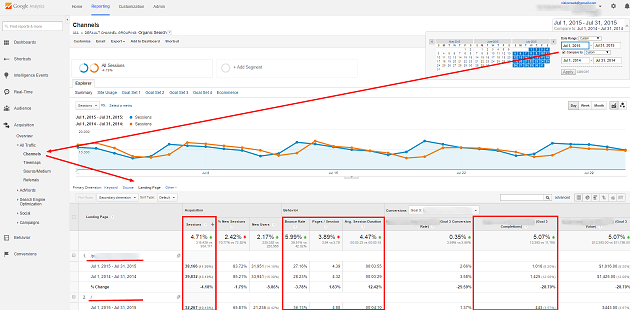
This may be seem like a “duh” entry into the top data points to review, but it is, and it is likely the most important so we don’t want to forget it. While we obviously want to compare YoY organic traffic by search engine, we also want to narrow it down to performance by page. This will help us understand if the homepage or specific folders, such as the blog, are carrying the success or decreases in comparison to last year.
Keep in mind that if you have undergone a URL rewrite within the last year, you will have incomparable data, as there will be internal pages that look like standout performers when in fact, they simply did not exist last year. Remember to consider this, as well as other instances, such as individual blog performance based on media related factors. A blog topic that was widely-searched last year may have been widely-forgotten by now.
Don’t just think about sessions when reviewing these pages. Be cognizant of user behavior metrics, as well as goal conversions, both on the whole and at the page level. This can be an indication of comparative visit quality in the last year and remind you to be mindful of the user experience.
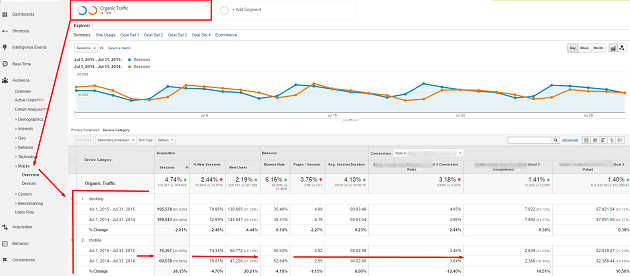
The times are changing and the devices used to arrive organically at your site are, as well. You should be concerned about organic traffic, user behavior and goal conversions, but don’t forget about how those users are getting to your site and how much this is changing each year. You will likely see that mobile is gobbling up organic traffic share and I hope that your mobile conversions are keeping up. This may lend insights into the need for mobile SEO best practice adherence.
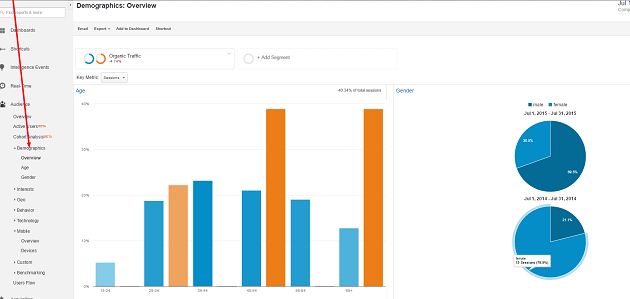
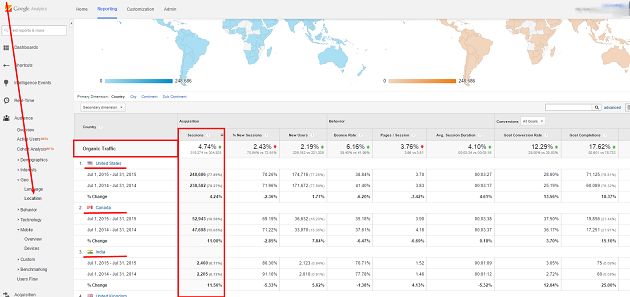
Just as we took our overall traffic and conversion blinders off for a moment above, let us not forget to review other user-specific elements, such as their location and demographic data. In comparison to the focus month from last year to now, are age groups of organic traffic changing? Does the dominant age of organic visitors correlate to your targeted user personas? Additionally, it may be great that organic has grown in YoY review, but looking at traffic by country of origin may help you to understand your growth. Is it happening in market-relative countries or is it arriving from irrelevant countries that you do not serve? If it is relevant and converts, you may have native content topics to address, as well as paid advertising target potential.

While SEO tools are great for auditing a site for things like broken links and non-indexed content, analytics can give us a YoY view of how well a site is managing 404 pages. By creating an advanced segment of organic and then drilling down through site pages and page title, we can then use a filter to only view views from pages that have title elements matching our custom 404 page. Using a secondary dimension of landing pages will also give you a good YoY view of whether we have internal and inbound links leading to 404s error pages, and if this number is higher or lower in the last year for our organic visitors.

I know, I know. Referring site traffic is not organic traffic. However, there can be a need to address a few issues that may assist in accurate organic traffic. From a month-to-month perspective, you may not see a noticeable trend in referring site traffic, but from a YoY comparison, changes may be glaring. What I am looking for here is subdomain/separate property referrals that may actually be a part of the conversion funnel and what organic users were truly interacting with. I am also going to look at the lift and drop in self-referrals. This may show that we need to address everything from analytics tracking for domain version issues to addressing SEO needs, such as a recent duplication of www. and non-www.
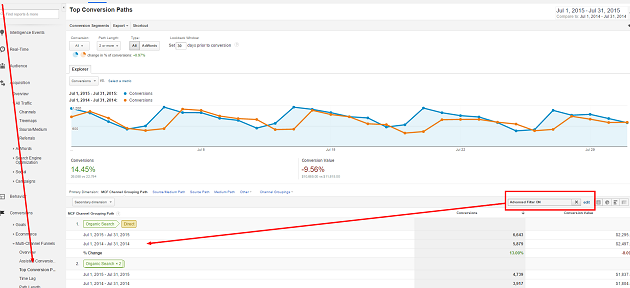
We just reviewed the consideration of other properties entering the site as a referral, when it was likely an organic entry initially. Let’s keep traveling down this road and consider the YoY difference in how organic as a first touchpoint has led to multiple visits and conversions through other channel entry. I typically like to set a filter to look at what multi-channel relationships began with an organic entry. Of course, I want to see an increase in multi-channel conversions, but it helps to understand if my organic users remember me and return through direct traffic to conversion, or whether hitting them with social, PPC or email is bringing them back to the site.

Our first point of analysis was reviewing YoY Organic performance by landing page; this data point is a similar approach, but we are reviewing landing page performance associated to keyword visibility in Google.
For this, I step away from Google Analytics and rely on SEMRush. The two exports I will look at are the previous month, as well as that month from last year. My preference is to export into Excel and sort by landing page, and also by search volume. This helps me understand which sections of the site are performing well by amount of ranking keywords, as well as the amount of high search volume terms that they are ranking for. Addressing births or loss gaps here is essential for understanding content needs on your site.

Google Search Console is a very insightful platform to help understand how Google perceives your site. However, there are several helpful areas only showing data from a rolling 90-day view. With this in mind, my YoY point of reference is the Index Status screen. This helps my forgetful mind compare this year with how many pages we had indexed this time last year, as well as how many pages were being restricted by robots.txt. Indexed pages themselves are not a determinant of SEO success, but it does help to understand if there is a correlation: having a lot of content created in the last year alongside seeing large organic traffic gains, for instance.

Links, which I often refer to as the right leg of SEO, are an essential component of a well-oiled SEO effort. While deep analysis needs to be done often as it relates to accrual of links from high authority domains, I want to take a look at total referring domains from a YoY perspective. For this, I rely on backlinks data from Majestic. By looking at the referring domain history section from a year-long and cumulative view, one can get a sense of link accrual moving in the right direction.
Hopefully the aforementioned data points have given you a little more insight on SEO success vs. a month-over-month or quarter-over-quarter review. A 12-month spread in data paired with similar seasonal effects will always paint the clearest picture on where you need to focus your SEO efforts – and where you need to start bragging!